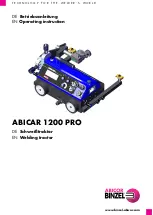
40
Culligan® M1 Series Reverse Osmosis
40
Cat. No. 01022940
6. Remove the end of concentrate tubing from the drain and place it in the solution tank.
7. Apply power to the unit, and then press the RUN NOW button. Allow the acid solution to circulate for 30 min-
utes. During recirculation, monitor the pH of the solution. If the pH rises above 3.0, add acid to reduce the pH to
2.0.
CAUTION! The temperature of the chemical solution will rise as it is recirculated. If the temper-
ature exceeds 95°F, turn the power switch to OFF and allow the solution to cool to
prevent damage to the RO elements.
NOTE A plastic gallon jug filled with ice may be placed in the solution to cool it.
8. When 30 minutes have passed, adjust the system pressure to the pressure recorded in Step 9. Measure the
product flow rate, then compare this flow to the flow recorded in Step 9. If cleaning is successful a noticeably
higher product flow should now be observed.
9. Turn the unit power off. If the cleaning was for removal of hardness scale or iron only, go to “Direct feed con-
Step 2: Clean Silt or Biofouling
1. If the cleaning was for silt or biofouling, take a 250 ml sample of phosphoric acid solution and carefully add
sodium hydroxide until the pH is at least 12. If the solution turns cloudy, it contains hardness and/or iron.
Discard the contaminated acid and prepare a fresh 30 gallons of phosphoric acid solution.Add sodium hydroxide
to the phosphoric acid solution. The pH of the solution should be increased to 11.0-11.5.
NOTE The result is an alkaline solution of tri-sodium phosphate (TSP), a common ingredient in detergents.
2. If the solution remains clear, direct the concentrate tubing to drain, apply power to the unit, and then press the
RUN NOW button. Check that the unit is drawing chemical solution.
CAUTION! If the pump is noisy, cavitation is occurring and the pump will be damaged. Turn the
unit power off and check for any obstructions to flow. Reduce the pump pressure as
required to prevent cavitation.
3. After approximately 5 gallons have been drawn from the solution tank, turn the unit power off.
4. Allow the elements to soak for 15 minutes. Apply power to the unit, and then press the RUN NOW button. Draw
another 5 gallons from the solution tank. Turn the unit power off.
5. Remove the end of concentrate tubing from the drain and place it in the solution tank. Apply power to the unit,
and then press the RUN NOW button. Allow the alkaline solution to circulate for 30 minutes. During recirculation
monitor the pH of the solution. If the pH drops below 10.0 add sodium hydroxide to increase the pH to 11.5.
NOTE If the caustic solution becomes dark brown (like coffee), it probably is saturated with organic material.
Discard the solution and prepare a fresh batch of phosphoric acid and sodium hydroxide.
For more accurate testing, use a Hach Model DE-2 detergent test kit or equivalent to ensure that the
product water is less than 0.05 ppm detergent.
A plastic gallon jug filled with ice may be placed in the solution tank to cool the solution.
CAUTION! The temperature of the chemical solution will rise as it is recirculated. If the temper-
ature exceeds 95°F, turn the unit power off and allow the solution to cool to prevent
damage to the RO elements.
Summary of Contents for M1 Series
Page 83: ...Notes 79 Cat No 01022940 Notes ...
Page 84: ......
















































